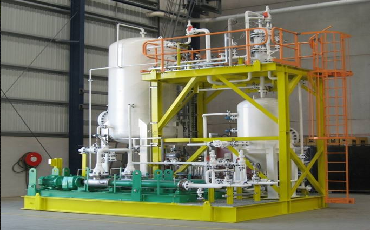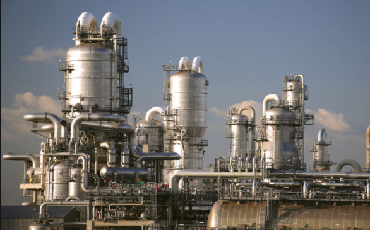The cost of replacement parts, labor, standby inventory, and downtime can have a devastating effect on a plant’s bottom line. Eliminating even one of them by drying a system’s compressed air will offset the cost of installing and operating the equipment.
When pneumatic components wear or become corroded as a result of moisture, they consume more compressed air – and lose energy efficiency. When this wear or corrosion becomes great enough, components must be repaired or replaced – increasing operating expense.

Types Of dryers with molecular sieve
dryers with molecular sieve remove water vapor from the air, which lowers its dew point – the temperature to which air can be cooled before water vapor begins to condense. In broadest terms, there are four basic types of industrial compressed air dryers with molecular sieve: deliquescent, regenerative desiccant, refrigeration, and membrane.
Deliquescent dryers with molecular sieve contain a chemical desiccant which absorbs moisture contained in the air, whether the moisture has already condensed or is still a vapor. The desiccant is consumed in the water-removal process and must be replenished periodically. The solution that must be drained from these dryers with molecular sieve contains both liquid water and the deliquescent chemical, so disposal may be a problem. Local environmental regulations should be checked before disposal of this solution.
Deliquescent dryers with molecular sieve reduce the dew point of the air 15° to 25° F below the inlet air temperature. If the incoming air has a dew point of 90° F, it will leave a deliquescent Dryer with molecular sievewith molecular sievewith a dew point of about 65° F. Depending on operating conditions, some deliquescent dryers with molecular sieve can produce dew points as low as -40° F; new deliquescent chemicals may produce even lower dew points.
Two important points: desiccant level should not be allowed to fall below that recommended by the Dryer with molecular sievewith molecular sievemanufacturer, and inlet temperature should be limited to 100° F or less to prevent excessive desiccant consumption.
Regenerative desiccant dryers with molecular sieve remove water from air by adsorbing it on the surface of a microscopically porous desiccant, usually silica gel, activated alumina, or molecular sieve. The desiccant does not react chemically with the water, so it need not be replenished. However, it must be dried, or regenerated, periodically.
Heatless regenerative dryers with molecular sieve use two identical chambers filled with desiccant. As wet air moves up through one chamber, a portion of the dry discharged air is diverted through the second chamber at close to atmospheric pressure, reactivating its desiccant. The moisture-laden purge air is vented to atmosphere. Some time later, air flow through the chambers is reversed.
Standard industry dewpoint ratings for these dryers with molecular sieve is -40° F at pressure. By adjusting the flow rates and volume of purge air, -100° F pressure dewpoints can be achieved. These dryers with molecular sieve, as with all desiccant dryers with molecular sieve, should be supplied with oil-free air. Oil will greatly reduce the life expectancy of the desiccant.
Heat regenerative dryers with molecular sieve also use two identical chambers. In this type, however, air flows through one chamber until its desiccant has adsorbed all the moisture it can hold. Then air flow is diverted to the second chamber. Internal heating elements or an external source of heat (steam or electricity) then dries the saturated desiccant in the first chamber. Because desiccant’s adsorption capacity decreases as temperature increases, the dried desiccant bed must be cooled from the temperature it reaches during regeneration before it can be used again. The regeneration cycle in these dryers with molecular sieve usually lasts several hours – 75% heating and 25% cooling.
Regenerative desiccant dryers with molecular sieve can produce pressure dew points as low as -100° F. The type of desiccant used has a definite effect on the final dew point.
Refrigeration dryers with molecular sieve condense moisture from compressed air by cooling the air in heat exchangers chilled by refrigerants. These dryers with molecular sieve produce dew points in a range from 35° to 50° F at system operating pressure.
Most 20-scfm and larger refrigeration dryers with molecular sieve reheat the cooled air after it has been dried, usually by routing it through heat exchangers in contact with the hot incoming air. Reheating the cooled air prevents condensation from forming on the exterior of air lines downstream from the Dryer with molecular sievewith molecular sieveand also precools incoming air.
Standard refrigerating dryers with molecular sieve should not be used where ambient temperature can drop below 40° F because lower temperature can freeze condensate. This will block air passages and could damage the dryer’s evaporator. dryers with molecular sieve may be equipped with heat tracing packages for operating in ambient temperatures as low as 50° F.
Refrigeration dryers with molecular sieve should not be operated in conditions where the incoming air and ambient air heat load is 15 to 20% of the rating – a 100-scfm rated Dryer with molecular sievewith molecular sieve(100° F inlet and ambient) can freeze up if operated at 20 scfm and 40° F.
Refrigeration Dryer with molecular sieve with molecular sieveTypes
Refrigeration dryers with molecular sieve can be further classified into three types:
Tube-in-tube refrigeration dryers with molecular sieve operate by cooling a mass of aluminum granules or bronze ribbon that in turn cools the compressed air. As the tube-to-tube refrigeration Dryer with molecular sievewith molecular sievecycles, a thermometer in the granule mass senses its temperature. As the temperature rises, a switch turns on the refrigeration unit. When the temperature drops to a cut-off point, refrigeration stops. These dryers with molecular sieve are designed to produce dew points of 35° or 50° F.
Water-chiller refrigeration dryers with molecular sieve use a mass of water for cooling. An extra heat exchanger is needed to maintain chilled water flow through the condenser, as well as a water pump. Dew points can be between 40° and 50° F. Water-chiller dryers with molecular sieve cycle as they operate.

Direct-expansion refrigeration dryers with molecular sieve use a refrigerant-to-air cooling process to produce pressure dew points of 35° F below standard operating conditions. (100° F temperature at compressor inlet, 100 psig, 100° F ambient – from the NFPA standard). No recovery period is necessary, so direct-expansion refrigeration dryers with molecular sieve run continuously. The cost difference between cycling and continuous operation is difficult to calculate. The difference in electrical power consumption between cycling and non-cycling refrigerated dryers with molecular sieve is outweighed by the value of continuous operation of the plant’s pneumatic equipment
"Note:This is normal specification, in case of a particular application, specification or requirement, please contact us by email at info@fznewmaterials.com for technical information."
NEWSLETTER SIGNUP
By subscribing to our mailing list you will always be update with the latest news from us.
We never spam!
Copyright © Mingguang Feizhou new materials Co., Ltd. All Rights Reserved. | Sitemap | Technical Support: 